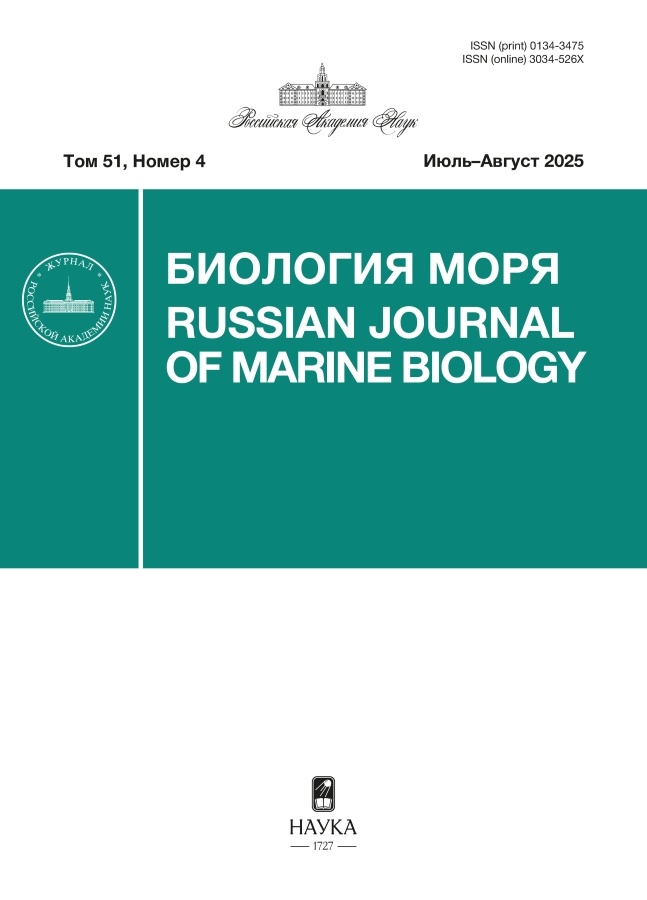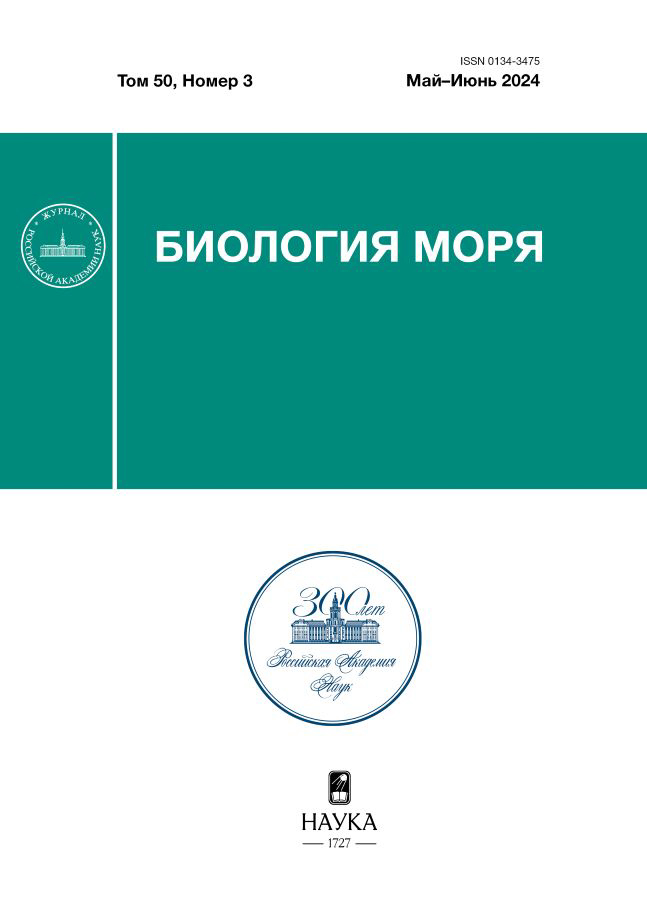Влияние вида и концентрации микроводорослей на рацион и продукцию яиц у копепод Calanipeda aquaedulcis Krichagin, 1873 и Arctodiaptomus salinus (Daday, 1885)
- Авторы: Аганесова Л.О.1, Ханайченко А.Н.1
-
Учреждения:
- Институт биологии южных морей им. А.О. Ковалевского (ИнБЮМ) РАН
- Выпуск: Том 50, № 3 (2024)
- Страницы: 217-228
- Раздел: ОРИГИНАЛЬНЫЕ СТАТЬИ
- Статья опубликована: 15.06.2024
- URL: https://ruspoj.com/0134-3475/article/view/670356
- DOI: https://doi.org/10.31857/S0134347524030044
- ID: 670356
Цитировать
Полный текст
Аннотация
В экспериментальных условиях исследовано влияние концентрации гаптофитовой Isochrysis galbana и динофитовой Prorocentrum cordatum микроводорослей на величину суточного рациона питания и скорость продукции яиц солоноватоводных копепод Arctodiaptomus salinus и Calanipeda aquaedulcis. Суточные рационы питания изученных копепод логарифмически возрастали с увеличением концентрации микроводорослей. Максимальные значения суточного рациона у обоих видов копепод были отмечены при питании I. galbana с концентрацией 170–196 мкг С/мл. Максимальные значения среднесуточной продукции яиц (EPR) у самок C. aquaedulcis (129% массы тела в углеродном эквиваленте) получены при питании микроводорослями I. galbana с концентрацией 15.4 мкг С/мл и P. cordatum с концентрацией 4 мкг С/мл. Максимальные значения EPR у самок A. salinus составляли 34% углеродного эквивалента массы самки при питании P. cordatum с концентрацией 26 мкг С/мл, и 45% углеродного эквивалента массы самки при питании I. galbana с концентрацией 8.9 мкг С/мл. Дальнейшее увеличение концентрации микроводорослей приводило к снижению значений EPR. Эффективность использования потребленной пищи на генеративную продукцию копепод в углеродном эквиваленте (GGE, %) была значительно выше у C. aquaedulcis, чем у A. salinus, и не зависела от вида и концентрации микроводорослей.
Полный текст
Об авторах
Л. О. Аганесова
Институт биологии южных морей им. А.О. Ковалевского (ИнБЮМ) РАН
Автор, ответственный за переписку.
Email: la7risa@gmail.com
ORCID iD: 0000-0003-4052-7985
Россия, Севастополь
А. Н. Ханайченко
Институт биологии южных морей им. А.О. Ковалевского (ИнБЮМ) РАН
Email: la7risa@gmail.com
ORCID iD: 0000-0002-4334-9996
Россия, Севастополь
Список литературы
- Аганесова Л.О. Длительность развития копепод Calanipeda aquaedulcis и Arctodiaptomus salinus при разном температурном режиме культивирования // Мор. экол. журн. 2013. Т. 12. № 1. С. 19–25.
- Аганесова Л.О. Размножение и развитие солоноватоводных копепод при кормлении микроводорослями разных видов // Биол. моря. 2021. Т. 47. № 2. С. 108–114. doi: 10.31857/S0134347521020029
- Вьюшкова В.П., Гурова Т.В. Находка солоноватоводного рачка Calanipeda aquaedulcis Kritsch (Copepoda, Calanoidae) в Волгоградском водохранилище // Зоол. журн. 1968. Т. 47. № 11. С. 1726–1727.
- Гарбер Б.И. Наблюдения за развитием и размножением Calanipeda aquae dulcis Kritsch (Copepoda: Calanoida) // Тр. Карадаг. биол. ст. 1951. Т. 2. С. 3–55.
- Гунько А.Ф., Алдакимова А.Я. Материалы о питании Calanipeda aquaedulcis (Crustacea, Calanoida) в Азовском море // Тр. АзНИИРХ. 1963. Вып. 6. С. 3–5.
- Ковалева Т.М. Влияние размеров и морфологических особенностей водорослей на потребление их копеподами // Биол. моря. 1977. Т. 42. С. 28–33.
- Кортунова Т.А., Буляева Л.Ф., Ярыгина О.К. Рачок калянипеда в Аральском море // Рыб. хоз-во. 1972. № 7. C. 32–34.
- Куделина Е.Н. Влияние температуры на размножение, развитие и плодовитость Calanipeda aquaedulcis Kritsch // Тр. Касп. бассейн. фил. ВНИРО. 1950. Т. 11. C. 265–286.
- Ханайченко А.Н. Влияние микроводорослевой диеты на характеристики воспроизводства копепод // Экол. моря. 1999. Т. 49. С. 56–61.
- Ханайченко А.Н., Поспелова Н.А., Аганесова Л.О., Рауэн Т.В. Каротиноидный состав каляноидных копепод Calanipeda aquaedulcis и Arctodiaptomus salinus при питании Dunaliella salina // Мор. экол. журн. 2014. Т. 13. № 1. С. 82–87.
- Шадрин Н.В., Батогова Е.А., Копейка А.В. Arctodiaptomus salinus (Daday, 1885) (Copepoda, Diaptomidae), редкий в северо-западной части Черного моря вид, обычен в прибрежных водах Крыма // Мор. экол. журн. 2008. Т. 7. № 2. С. 86.
- Andreev N.I., Plotnikov I.S., Aladin N.V. The fauna of the Aral Sea in 1989. 2. The zooplankton // Int. J. Salt Lake Res. 1992. V. 1. № 1. P. 111–116. doi: 10.1007/bf02904955
- Barkhatov Y.V., Tolomeev A.P., Drobotov A.V. The response of zooplankton abundance in saline meromictic Lake Shira to a change in circulation regime // J. Ocean. Limnol. 2023. V. 41. P. 1321–1330.
- doi: 10.1007/s00343-022-2132-z
- Berggreen U., Hansen B., Kiørboe T. Food size spectra, ingestion and growth of the copepod Acartia tonsa during development: implications for determination of copepod production // Mar. Biol. 1988. V. 99. № 3. P. 341–352. doi: 10.1007/bf02112126
- Besiktepe S., Dam H.G. Effect of diet on the coupling of ingestion and egg production in the ubiquitous copepod // Acartia tonsa, Prog. Oceanogr. 2020. V 186. Art. ID 102346. doi: 10.1016/j.pocean.2020.102346
- Brucet S., Compte J., Boix D. et al. Feeding of nauplii, copepodites and adults of Calanipeda aquaedulcis (Calanoida) in Mediterranean salt marshes // Mar. Ecol.: Prog. Ser. 2008. V. 355, P. 183–191.
- doi: 10.3354/meps07225
- Coutteau P. Micro-Algae / Manual on the Production and Use of Live Food for Aquaculture, FAO Fisheries Technical Paper, № 361, P. Lavens, P. Sorgeloos, Eds., Rome: FAO. 1996. P. 7–48.
- Dam H.G., Colin S.P. Prorocentrum minimum (clone Exuv) is nutritionally insufficient, but not toxic to the copepod Acartia tonsa // Harmful Algae. 2005. V. 4. P. 575–584. doi: 10.1016/j.hal.2004.08.007
- Deason E.E. Grazing of Acartia hudsonica (A. clausi) on Skeletonema costatum in Narragansett Bay (USA): Influence of food concentration and temperature // Mar. Biol. 1980. V. 60. P. 101–113. doi: 10.1007/BF00389153
- Durbin E.G., Durbin A.G. Effects of temperature and food abundance on grazing and short term weight change in the marine copepod Acartia hudsonica // Limnol. Oceanogr. 1992. V. 37. № 2. P. 361–378. doi: 10.4319/lo.1992.37.2.0361
- Frisch D., Rodríguez-Pérez H., Green A.J. Invasion of artificial ponds in Donana Natural Park, southwest Spain, by an exotic estuarine copepod // Aquat. Conserv. 2006. V. 16. № 5. P. 483–492.
- doi: 10.1002/aqc.718
- Frost B.W. Effects of size and concentration of food particles on the feeding behavior of the marine planktonic copepod Calanus pacificus // Limnol. Oceanogr. 1972. V. 18. № 6. P. 805–815.
- doi: 10.4319/lo.1972.17.6.0805
- Gonçalves A.M.M., Azeiteiro U.M., Pardal M.A., De Troch M. Fatty acid profiling reveals seasonal and spatial shifts in zooplankton diet in a temperate estuary // Estuarine, Coastal Shelf Sci. 2012. V. 109. P. 70–80. doi: 10.1016/j.ecss.2012.05.020
- Gubanova A.D., Prusova I.Yu., Niermann U. et al. Dramatic change in the copepod community in Sevastopol Bay (Black Sea) during two decades (1976–1996) // Senckenbergiana Maritima. 2001. V. 31. № 1. P. 17–27. doi: 10.1007/bf03042833
- Guerrero F., Jiménez-Melero R., Parra G. et al. Lipid composition of Arctodiaptomus salinus (Copepoda: Calanoida) // J. Freshwater Ecol. 2007. V. 22. № 1. P. 147–150. doi: 10.1080/02705060.2007.9664155
- Gurkan S., Aragoneses P., Innal D. et al. Trophic niches of two congeneric pipefishes in the Aegean Sea (Bargilya Wetland, Turkey), based on stable isotope analyses // Preprint. 2023. № 2023072072. doi: 10.20944/preprints202307.2072.v1
- Helenius L., Budge S.M., Johnson C.L. Stable isotope labeling reveals patterns in essential fatty acid growth efficiency in a lipid-poor coastal calanoid copepod // Mar. Biol. 2020. V. 167. Art. ID 178. doi: 10.1007/s00227-020-03794-8
- Jiménez-Melero R., Parra G., Guerrero F. Effect of temperature, and individual variability on the embryonic development time and fecundity of Arctodiaptomus salinus (Copepoda: Calanoida) from a shallow saline pond // Hydrobiologia. 2012. V. 686. P. 241–256. doi: 10.1007/s10750-012-1014-3
- Jiménez-Melero R., Parra G., Souissi S., Guerrero F. Post-embryonic developmental plasticity of Arctodiaptomus salinus (Copepoda: Calanoida) at different temperatures // J. Plankton Res. 2007. V. 29. № 6. P. 553–567. doi: 10.1093/plankt/fbm038
- Khanaychenko A.N., Telesh I.V., Skarlato S.O. Bloom-forming potentially toxic dinoflagellates Prorocentrum cordatum in marine plankton food webs // Protistology. 2019. V. 13. № 3. P. 95–125. doi: 10.21685/1680-0826-2019-13-3-1
- Kiørboe T., Sabatini M. Reproductive and life cycle strategies in egg-carrying cyclopoid and free-spawning calanoid copepods // J. Plankton Res. 1994. V. 16. № 10. P. 1353–1366. doi: 10.1093/plankt/16.10.1353
- Lacoste A., Poulet S.A., Cueff A. et al. New evidence of the copepod maternal food effects on reproduction // J. Exp. Mar. Biol. Ecol. 2001. V. 259. № 1. P. 85–107. doi: 10.1016/S0022-0981(01)00224-6
- Lapesa S., Snell T.W., Fields D.M., Serra M. Selective feeding of Arctodiaptomus salinus (Copepoda, Calanoida) on co-occurring sibling rotifer species // Freshwater Biol. 2004. V. 49. № 8. P. 1053–1061. doi: 10.1111/j.1365-2427.2004.01249.x
- Lazareva V.I. The Mediterranean copepod Calanipeda aquaedulcis Kritschagin, 1873 (Crustacea, Calanoida) in the Volga River Reservoirs // Inland Water Biol. 2018. V. 11. P. 303–309. doi: 10.1134/S1995082918030112
- Marrone F., Castelli G., Barone R., Naselli-Flores L. Ecology and distribution of calanoid copepods in Sicilian inland waters (Italy) // Verh. – Int. Ver. Theor. Angew. Limnol. 2006. V. 29. P. 2150–2156. doi: 10.1080/03680770.2006.11903072
- Paffenhöffer G.-A. Feeding rates and behavior of zooplankton // Bull. Mar. Sci. 1988. V. 43. № 3. P. 430–445.
- Plotnikov I.S., Aladin N.V., Mossin J., Høeg J.T. Crustacean fauna of the Aral Sea and its relation to ichthyofauna during the modern regression crisis and efforts at restoration // Zool. Studs. 2021. V. 60. № 25. doi: 10.6620/ZS.2021.60-25
- Ramdani M., Elkhiati N., Flower R.J. et al. Open water zooplankton communities in North African wetland lakes: the CASSARINA Project // Aquatic Ecol. 2001. V. 35. № 3–4. P. 319–333. doi: 10.1023/A:1011926310469
- Rokneddine A., Chentoufi M. Study of salinity and temperature tolerance limits regarding four crustacean species in a temporary salt water swamp (Lake Zima, Morocco) // Anim. Biol. 2004. V. 54. № 3. P. 237–253. doi: 10.1163/1570756042484719
- Støttrup J.G., Jensen J. Influence of algal diet on feeding and egg-production of the calanoid copepod Acartia tonsa Dana // J. Exp. Mar. Biol. Ecol. 1990. V. 141. № 2–3. P. 87–105. doi: 10.1016/0022-0981(90)90216-Y
- Svetlichny L., Hubareva E., Khanaychenko A. Calanipeda aquaedulcis and Arctodiaptomus salinus are exceptionally euryhaline osmoconformers: Evidence from mortality, oxygen consumption, and mass density patterns // Mar. Ecol.: Prog. Ser. 2012a, V. 470. P. 15–29. doi: 10.3354/meps09907
- Svetlichny L., Khanaychenko A., Hubareva E., Aganesova L. Partitioning of respiratory energy and environmental tolerance in the copepods Calanipeda aquaedulcis and Arctodiaptomus salinus // Estuarine, Coastal Shelf Sci. 2012b. V. 114. P. 199–207. doi: 10.1016/j.ecss.2012.07.023
- Suh S.S., Kim S.J., Hwang J. et al. Fatty acid methyl ester profiles and nutritive values of 20 marine microalgae in Korea // Asian Pac. J. Trop. Med. 2015. V. 8. № 3. P. 191–196. doi: 10.1016/S1995-7645(14)60313-8
- Tolomeev A.P. Phytoplankton diet of Arctodiaptomus salinus (Copepoda, Calanoida) in Lake Shira (Khakasia) // Aquat. Ecol. 2002. V. 36. № 2. P. 229–234.
- Tolomeev A.P., Sushchik N.N., Gulati R.D. et al. Feeding spectra of Arctodiaptomus salinus (Calanoida, Copepoda) using fatty acid trophic markers in seston food in two salt lakes in South Siberia (Khakasia, Russia) // Aquat. Ecol. 2010. V. 44. № 3. P. 513–530.
- doi: 10.1007/s10452-010-9331-y
- Ustaoğlu M.R. A check-list for zooplankton of Turkish inland waters // Eur. Union J. Fish. Aquat. Sci. 2004. V. 21. № 3–4. P. 191–199.
- Vincent M., Ceccaldi H.J. Relations entre acides gras et pigments caroténoïdes chez un crustacé copépode, Calanipeda aquae-dulcis // Biochem. Syst. Ecol. 1988. V. 16. № 3. P. 317–324. doi: 10.1016/0305-1978(88)90017-8
Дополнительные файлы













